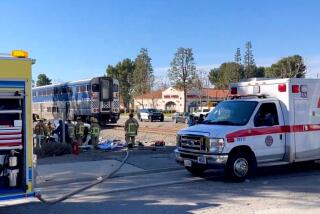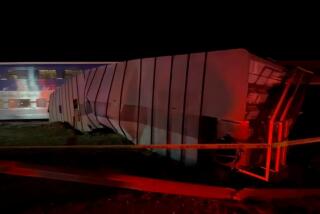Chicago train was going too fast for emergency system to stop crash
A preliminary investigation into the crash of a Chicago Transit Authority train that derailed and jumped onto a passenger platform at the O’Hare International Airport station found that the train was going too fast for the station’s automatic emergency braking system to prevent the crash.
The Blue Line train was going about 26 miles per hour when it activated the mechanism, the National Transportation Safety Board said.
“Due to the train speed, the distance from the fixed trip stop to the track bumper post was too short to stop the train,” the report said.
The train struck a barrier and derailed onto the platform on March 24 at about 2:50 a.m., coming to rest on top of an escalator. The accident, the report said, sent the train operator and 32 train passengers to hospitals.
The crash caused $9.1 million in damages.
The unidentified driver was fired Friday for two alleged significant safety violations, the Chicago Transit Authority said.
The operator told NTSB investigators that she had fallen asleep as the train entered the station and woke up just as the train crossed the fixed trip stop, which was just beyond the stop signal. She said she had worked nearly 60 hours over the previous seven days and was working her third consecutive night shift.
The driver also said she had insufficient sleep the night before the crash.
The driver, who had been on the job about two months, had a constantly changing schedule, the NTSB said. She told investigators that she had dozed off while operating a train the previous month. Between that violation and the O’Hare crash, the CTA said it had enough grounds to fire her.
Transit officials said they don’t believe her work schedule played a role in the crash, but announced a series of changes that the agency said will make its scheduling guidelines some of the most stringent among the nation’s large transit operations.
Twitter: @AdolfoFlores3
More to Read
Start your day right
Sign up for Essential California for news, features and recommendations from the L.A. Times and beyond in your inbox six days a week.
You may occasionally receive promotional content from the Los Angeles Times.







